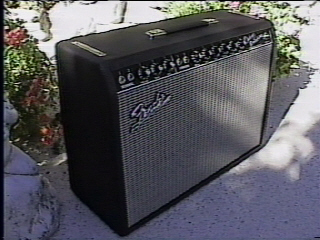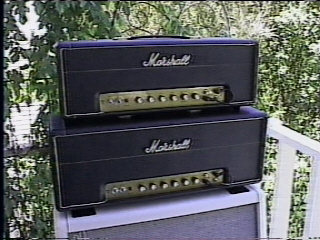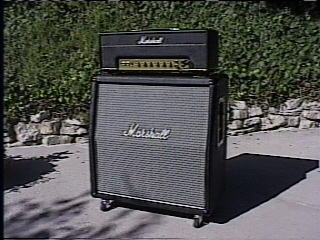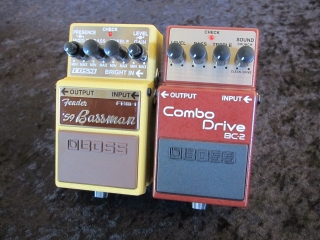Guitar Amplifiers
This page displays my personal collection of (reissue) guitar amplifiers. Alternatively, I also employ modeling technology to emulate the TONES of said gear, which have become inspirations for my personally-crafted Line 6 presets (via the Line 6 POD HD Pro). Ultimately, I choose a modeling processor to record direct, because I prefer the sound—as compared to employing a microphone. That way, I avoid extraneous noise arriving from outside of my home : vehicles, airplanes, barking dogs, etc. Previously, I had spent years becoming familiar with the rich TONES of tube/ valve amplifiers. As result of having a well-tuned ear, I am now able to craft digital emulations—as well as, mixtures of related components : amplifier + loudspeaker. Provided below, is a generalized history of the amps from my personal collection.
1959 : Fender 5F6A Bassman Amplifier

The original (50 Watt) tweed-covered Bassman was the first-ever amplifier, designed to complement the first (commercial) electric bass guitar—both, designed and manufactured by Fender Musical Instruments, during the 1950s era. Nonetheless, guitar players later discovered that this model sounds equally-good for their own purposes—thus, providing the necessary volume level to compete with the drums, and also having a sound that ranges from a warm/ full-bodied, clean voice . . to a naturally-organic over-driven TONE. Musicians, sound engineers, and music producers have often employed this particular model, in relation to various genres of music—i.e., blues, R&B, Classic Rock, country, and jazz. Incidentally, the 5F6A Bassman model became the inspiration for other amplifier circuit designs—i.e., Marshall JTM 45.
The Bassman amplifier includes the following features :
* 2x 6L6 Output Tubes/ Valves
* 4x 10″ Jensen loudspeakers
“1963” : Vox AC15TBX Top Boost Amplifier

Vox was the first great British amplifier manufacturer, beginning in 1958 with the AC15 model. The original Vox AC15 (15 Watt) amp never actually, included the Top Boost circuit. Rather, the updated AC15TBX model borrowed this feature from the more powerful (30 Watt) AC30 amplifier—employed by music groups, such as The Beatles, and Queen. The essential Vox sound character ranges from a clean voice, to a smooth, over-driven TONE. Moreover, the classic Vox circuit design is “Class A” (which can also be described as extremely touch-sensitive, sound-wise).
The AC15TBX amplifier is ultimately, a custom model—including the following features :
* Top Boost Circuit
* Master Volume control
* Spring Reverb
* Tremolo
* 2x EL84 Output Tubes/ Valves
* 1x Celestion G12 alnico “Vox Blue” loudspeaker
1965 : Fender Deluxe Reverb Amplifier

The Deluxe Reverb was/ is considered to be a versatile (22 Watt) guitar amplifier. For example : musicians, sound engineers, and music producers have often employed this particular model, in relation to various genres of music—i.e., surf, blues, Classic Rock, soul, and country. That said, the sound ranges from a clean voice, to a smooth, over-driven TONE.
The Deluxe Reverb amplifier includes the following features :
* Spring Reverb
* Vibrato
* 2x 6V6 Output Tubes/ Valves
* 1x 12″ Jensen loudspeaker
1965 : Marshall JTM 45 Amplifier

Despite of it’s original 35 Watt power rating, the Marshall MkII model was the loudest guitar amplifier ever produced—in close collaboration with particular guitar players of the era; including, Pete Townsend (The Who fame). That said, it was Townsend whom gave final approval to the JTM 45 circuit design. Ultimately, he wanted the amplifier to produce a loud volume level to compete with the drums, plus a combination of TONES : clean voice (i.e., Fender amplifier), as well as an over-driven sound to arrive from the amplifier, itself—not the loudspeakers. After various circuit prototypes, the original Marshall MkII was then ready for commercial production (circa 1962)—and, is the genesis of what has become the sound of Rock music. During 1964-1965, the output volume was increased to 45 Watts, in relation to employing KT66 output tubes/ valves, and was thus considered to be “perfect”. The original tube/ valve type for the Marshall JTM 45 was the 5881—later substituted for 6L6, and finally, KT66.
The very first “JTM45” units were actually named, MkII—not JTM45 (the MkI designation was only meant for the prototype version). Also of interesting note, the Fender 5F6A Bassman amplifier became the inspiration for the Marshall MkII (JTM 45) circuit design—because @ that time (circa 1962), the 5F6A model was the favorite of local guitarists in London, England. That said, the MkII model was such a commercial and TONEFUL success, that nearly every electric guitar player with a band in the area was employing its use to rival (or, surpass) the volume level of their drummer. In fact, on its first day of sale, 25 units had been sold. One notable artist whom relied upon the Marshall JTM 45, was Eric Clapton (John Mayall and the Bluesbreakers fame). Moreover, Clapton had then employed both versions of this model @ different times—a JTM 45 half-stack, and later, the 1962 combo.
Marshall amplifiers in the “non-combo” format (as shown, herein) require a separate speaker cabinet—available in different models, and relatively include different loudspeaker types. That said, the 1987X 50 Watt MkII model pictured below, is shown with a Marshall 1960A cabinet which houses 4x reissue Celestion (25 Watt) G12 “greenback” speakers. When this type of loudspeaker is pushed to its volume limits, such helps to further increase the overall gain (distortion) of the amplified TONE. In a relative manner, of course, the same applies to that of the Marshall 100 Watt amp—only, due to its increased volume output, the necessity of two 4x 12 cabinets must be employed to prevent speaker damage.
1968 : Marshall 1959SLP/ Super Lead Plexi Amplifier

Originally, as with the 45 Watt model before it, the Marshall MkII 100 Watt Lead amp was the loudest guitar amplifier ever produced—in close collaboration with particular guitar players of the era; including, Pete Townsend (The Who fame). That said, it was Townsend whom requested Jim Marshall to build a louder model than the JTM 45 (circa 1965). Essentially, two additional output tubes/ valves had thus been incorporated into the circuit design. As result, the overall musical TONE was altered—especially, when said valves were later changed from the KT66 type, to that of the EL34 (circa 1966). Ultimately, the 100 Watt Lead model with EL34 output valves produces greater gain (more distortion)—as well, having increased treble and tighter/ focused bass response.
Marshall amplifiers in the “non-combo” format (as shown, herein) require a separate speaker cabinet—available in different models, and relatively include different loudspeaker types. That said, the 1987X 50 Watt MkII model pictured below, is shown with a Marshall 1960A cabinet which houses 4x reissue Celestion (25 Watt) G12 “greenback” speakers. When this type of loudspeaker is pushed to its volume limits, such helps to further increase the overall gain (distortion) of the amplified TONE. In a relative manner, of course, the same applies to that of the Marshall 100 Watt amp—only, due to its increased volume output, the necessity of two 4x 12 cabinets must be employed to prevent speaker damage.
The Marshall MkII 1959 amplifier was employed by some very notable artists of the Psychedelic and Classic Rock eras (including, Eric Clapton/ The Cream fame, Jimi Hendrix, and Jimmy Page), in part, due to inferior P.A. systems being unable to properly project necessary volume levels to an audience from the furthest rows of a concert venue. That said, Page also needed 100+ watts of power to compete with John Bonham’s loud drumming! Ultimately, many guitarists have since, relied upon a vintage Marshall 100 Watt Lead amplifier (i.e., Eddie Van Halen—prior to using his signature model amps).
“1972” : Marshall 1987X Amplifier

The original Marshall MkII 50 Watt Lead amplifier (model 1987) from 1966, produces less gain (distortion) than the reissue (model 1987X). Moreover, the overall TONE of the reissue is akin to that of the circa 1972 version of this design. As well, model 1987X does not have the proper appearance of the 1972 version, either—it is housed in a “small box” cabinet, as oppose to the larger, standardized size introduced in 1972. Ultimately, the 1987X model is not an exact reissue; rather, a combination of vintage-inspired features.
By comparison to the Marshall JTM 45, the TONE of the original 1959 and 1987 amplifiers (incl. the reissue models), are considerably different—in that, they employ EL34 output tubes/ valves, and a solid-state rectifier. Such makes for an altogether . . more distorted, louder, and brighter-voiced design; along with having a tighter/ focused bass response. Two notable artists who prefer the sound of the Marshall 50 Watt Lead amplifier are Jeff Beck, and Yngwie J. Malmsteen.
Marshall amplifiers in the “non-combo” format (as shown, herein) require a separate speaker cabinet—available in different models, and relatively include different loudspeaker types. That said, the 1987X 50 Watt MkII model pictured left, is shown with a Marshall 1960A cabinet which houses 4x reissue Celestion (25 Watt) G12 “greenback” speakers. When this type of loudspeaker is pushed to its volume limits, such helps to further increase the overall gain (distortion) of the amplified TONE. In a relative manner, of course, the same applies to that of the Marshall 100 Watt amp—only, due to its increased volume output, the necessity of two 4x 12 cabinets must be employed to prevent speaker damage.

Modeling Technology
The Marshall 1987X amplifier is the inspiration for my favorite, personally-crafted Line 6 preset. Otherwise, having altered said preset TONE by substituting the matching Marshall 1960 speaker cabinet (i.e., 4x 12″ Celestion “greenback” loudspeakers) for a Fender Deluxe Reverb speaker cabinet—housing a 1x 12″ Jensen loudspeaker. As result, having created a less-intense (sweeter-sounding), overall TONE. In the physical world, substituting said loudspeaker cabinets would NOT be recommended, due to their power rating differences, etc. And that is yet, another reason why I choose Line 6 modeling technology.
Ultimately, I choose a modeling processor to record direct, because I prefer the sound—as compared to employing a microphone. That way, I avoid extraneous noise arriving from outside of my home : vehicles, airplanes, barking dogs, etc. Previously, I had spent years becoming familiar with the rich TONES of tube/ valve amplifiers. As result of having a well-tuned ear, I am now able to craft digital emulations—as well as, mixtures of related components : amplifier + loudspeaker.
TONE Tip :

In relation to the aforementioned Line 6 technology (i.e., “Vox AC30” and “Fender Bassman” models), I have enhanced such with the following effects units, respectively :
* BOSS BC-2 (British) Combo Drive effects pedal
* BOSS FBM-1 Fender 1959 Bassman effects pedal
By combining the TONES of digital modeling technology with effects pedals, it is possible to create emulated sounds of actual guitar amplifiers.
This Website :
The intention of fuzz-effect-sounds-and-more.com is to provide a reference resource; virtually sharing my gear collection, so that readers are made greater-aware of particularly good-sounding (and, in some instances), potentially collectible effects pedals. Otherwise, to also help those whom might benefit from my recording/ engineering techniques. Ultimately, as I continue to build and design this site, I will gradually introduce additional collection-based content—such as blog posts, image galleries, audio, video, and official manufacturer web links for your convenience. The information provided herein, is based upon biased opinion. Please, do your own research.
Ebooks :
Later . . I will offer for sale Part 1 of a series of self-authored eBooks, in relation to fuzz effects pedals; subsequently, also offering additional volumes regarding other effects types—boost, overdrive, distortion, etc—all via my private, independent collection. Moreover, these tomes of tone will include audio examples, color images, (in most cases) close-up circuit views, and generalized spec. information. Otherwise, said eBooks regarding fuzz effects pedals will additionally incl. generalized historical information as well. For details, please read this site’s eBook advertisement page.
Disclaimer of Copyright and Trademark :
Product names, trademarks, and artists’ names (incl. the names of builders and designers) referred to, and/ or depicted herein are the property of their respective owners, which are in NO way associated or affiliated with fuzz-effect-sounds-and-more.com. Said, names and trademarks are used solely to identify products whose sounds were studied during the audio production efforts for this reference resource. The use of said, names and trademarks does NOT imply any cooperation or endorsement. NO copyright, nor trademark infringement intended. Any errors, omissions or variations in the subject-matter details are unintentional.
Disclaimer of External Web Links :
EXTERNAL web links are provided as a convenience, and for informational purposes only; they do NOT constitute an endorsement or an approval by fuzz-effect-sounds-and-more.com of any of the products, services or opinions of the corporation or organization or individual. fuzz-effect-sounds-and-more.com bears NO responsibility for the accuracy, legality or content of the external site or for that of subsequent links. Contact the external site for answers to questions regarding its content.

This Website & Its Contents : Copyright © fuzz-effect-sounds-and-more.com